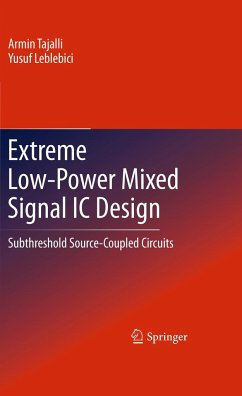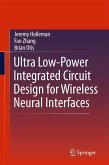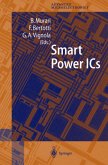This book describes a completely novel class of techniques for designing ultra-low-power integrated circuits (ICs). In many applications such as battery operated systems and battery-less (energy-scavenging) systems, power dissipation is a critical parameter. As a result, there is a growing demand for reducing the power (energy) consumption in ICs to extremely low levels, not achievable by using classical "subthreshold CMOS" techniques. This book introduces a new family of "subthreshold circuits" called "source-coupled circuits". This family of circuits can be used for implementing digital (logic) circuits that dissipate far less than 1fJ per switching event, yet maintain the noise margins that are necessary for robust operation. This book also explains how the techniques used for implementing ultra low-power digital circuits could be extended for implementing analog circuits. Developing a uniform basis for designing ultra-low-power digital and analog circuits provides the basis for realizing complicated mixed-signal integrated systems.
Design exibility and power consumption in addition to the cost, have always been the most important issues in design of integrated circuits (ICs), and are the main concerns of this research, as well. Energy Consumptions: Power dissipation (P ) and energy consumption are - diss pecially importantwhen there is a limited amountof power budgetor limited source of energy. Very common examples are portable systems where the battery life time depends on system power consumption. Many different techniques have been - veloped to reduce or manage the circuit power consumption in this type of systems. Ultra-low power (ULP) applications are another examples where power dissipation is the primary design issue. In such applications, the power budget is so restricted that very special circuit and system level design techniquesare needed to satisfy the requirements. Circuits employed in applications such as wireless sensor networks (WSN), wearable battery powered systems [1], and implantable circuits for biol- ical applications need to consume very low amount of power such that the entire system can survive for a very long time without the need for changingor recharging battery[2-4]. Using newpowersupplytechniquessuchas energyharvesting[5]and printable batteries [6], is another reason for reducing power dissipation. Devel- ing special design techniques for implementing low power circuits [7-9], as well as dynamic power management (DPM) schemes [10] are the two main approaches to control the system power consumption. Design Flexibility: Design exibility is the other important issue in modern in- grated systems.
Design exibility and power consumption in addition to the cost, have always been the most important issues in design of integrated circuits (ICs), and are the main concerns of this research, as well. Energy Consumptions: Power dissipation (P ) and energy consumption are - diss pecially importantwhen there is a limited amountof power budgetor limited source of energy. Very common examples are portable systems where the battery life time depends on system power consumption. Many different techniques have been - veloped to reduce or manage the circuit power consumption in this type of systems. Ultra-low power (ULP) applications are another examples where power dissipation is the primary design issue. In such applications, the power budget is so restricted that very special circuit and system level design techniquesare needed to satisfy the requirements. Circuits employed in applications such as wireless sensor networks (WSN), wearable battery powered systems [1], and implantable circuits for biol- ical applications need to consume very low amount of power such that the entire system can survive for a very long time without the need for changingor recharging battery[2-4]. Using newpowersupplytechniquessuchas energyharvesting[5]and printable batteries [6], is another reason for reducing power dissipation. Devel- ing special design techniques for implementing low power circuits [7-9], as well as dynamic power management (DPM) schemes [10] are the two main approaches to control the system power consumption. Design Flexibility: Design exibility is the other important issue in modern in- grated systems.








